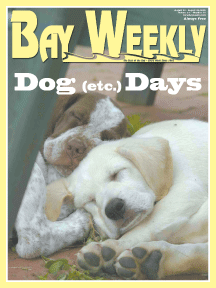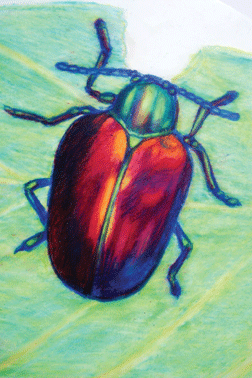
Volume XVII, Issue 34 # August 20 - August 26, 2009 |
 |
 |
Earth Journal by Gary Pendleton
Dogbane It!
 |
The complicated play of reflected light creates the shimmering metallic-looking surface of the beetle. |
Beetles and butterflies love it, dogs hate it
This is a dogbane beetle; it is feeding on the leaves of a dogbane plant. Butterflies also like dogbane and feed on the flowers. The plant, Apocynum cannabium (it means: Away, dog! hemp-like), is related to milkweed. To play it safe, dogs might want to avoid eating any part of it.
Dogbane has milky, bitter sap, but it won’t kill the dog or you, mainly because it tastes so nasty that neither you nor Fido would ever eat enough to cause much harm beyond a very upset stomach. Still, the sap is loaded with alkaloids. Some plants in the family are poisonous; others are used to manufacture powerful heart medications.
The second part of the scientific name (cannabium) refers to the plant’s hemp-like, fibrous stem, which can be used to make string or rope. Indian hemp is among the many common names of the plant. It was used by Native Americans to make string that could be woven into rope or made into pouches or sacks. I have a simple souvenir: a piece of brown string that many years ago I made from the dried stalks of dogbane.
Dogbane beetles (Chrysochus auratus) are harmless. As far as I can tell, all they do is eat the leaves of dogbane and milkweed and make little beetles. They are often mistaken for Japanese beetles, which are pests.
The dogbane beetles are about a half-inch long and iridescent. You might think they are of polished copper. The color seems to change and shimmer because the surface is made of microscopic stacks of slanting plates under which is pigment. When light strikes the surface of the beetle, some of it reflects directly off the slanting plates, and some rays penetrate to the pigmented surface below to be reflected back to the eye of the beetle watcher. The complicated play of light creates the shimmering metallic-looking surface of the beetle.
Scientific name: Plant: Apocynum cannabium; Beetle: Chrysochus auratusWhat to look for: A half-inch-long, shiny red and green beetle, feeding on the pale green leaves of the dogbane plant.Where to look: Roadsides, fence rows and meadows.Places to visit: Jefferson Patterson Park in Calvert County or the B&A Trail in Anne Arundel County. |
![]() The dogbane plant grows three to four feet high and produces multiple, small white flowers. The leaves are pale green and oval. The long, slender seed pods turn brown in the fall and are full of white fluff. In winter, when the pods split, the fluff floats on the wind and can carry the abundant seeds long distances. Dogbane can be found in meadows, vacant lots and along roadsides. It is a great butterfly plant and is easy to grow from seeds that you can collect from plants you find in the wild.
The dogbane plant grows three to four feet high and produces multiple, small white flowers. The leaves are pale green and oval. The long, slender seed pods turn brown in the fall and are full of white fluff. In winter, when the pods split, the fluff floats on the wind and can carry the abundant seeds long distances. Dogbane can be found in meadows, vacant lots and along roadsides. It is a great butterfly plant and is easy to grow from seeds that you can collect from plants you find in the wild.
Beware, however. The fact that it is easy to grow and produces an abundance of seeds means that you will be weeding the plant out of places where you don’t want it growing. But if you give dogbane a sunny spot and make an effort to thin excess plants before they go to seed, you will have a nice addition to a dogless butterfly garden. The beetles will be a bonus.